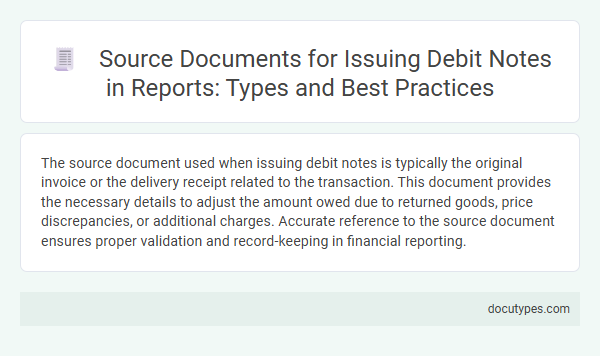The source document used when issuing debit notes is typically the original invoice or the delivery receipt related to the transaction. This document provides the necessary details to adjust the amount owed due to returned goods, price discrepancies, or additional charges. Accurate reference to the source document ensures proper validation and record-keeping in financial reporting.
Introduction to Source Documents for Debit Notes
What source document is used when issuing debit notes? A debit note is typically issued based on a source document such as a purchase invoice or a delivery receipt indicating discrepancies or returns. These documents provide the necessary details to justify the debit note, ensuring accurate record-keeping and communication between buyer and seller.
Importance of Accurate Source Documentation
Source documents used when issuing debit notes typically include purchase orders, delivery receipts, and original invoices. These documents provide the necessary details to validate the reason for debit adjustments and ensure proper accounting records.
Accurate source documentation is crucial for maintaining transparency and preventing disputes between buyers and sellers. Proper records also facilitate efficient audit trails and compliance with financial regulations.
Common Types of Source Documents Used for Debit Notes
| Source Document | Description | Purpose in Issuing Debit Notes |
|---|---|---|
| Invoice | Original sales invoice issued by the seller to the buyer outlining goods or services provided. | Acts as a baseline document to identify discrepancies such as undercharges, prompting a debit note to adjust the payment. |
| Purchase Order (PO) | Formal request issued by the buyer to the seller specifying items, quantities, and agreed prices. | Serves as a reference to verify discrepancies in quantity or price, which necessitates issuing a debit note to correct the billing. |
| Delivery Note | Document confirming the delivery of goods, including details like quantity and condition upon receipt. | Used to validate shipment details; discrepancies between delivery note and invoice lead to debit notes for adjustments. |
| Credit Note | Document issued to acknowledge a reduction in the amount payable from a previous invoice. | If a credit note was under-applied or incorrectly calculated, a debit note may be issued to recover the balance owed. |
| Contract or Agreement | Legally binding document outlining terms and pricing agreed upon by buyer and seller. | Provides terms reference ensuring that debit notes comply with contractual agreements when correcting financial records. |
Purchase Orders as Reference Documents
Purchase orders serve as the primary source documents when issuing debit notes. These documents provide a detailed record of agreed-upon terms between the buyer and seller.
Your debit note references the purchase order to validate discrepancies such as pricing errors or quantity differences. This ensures accuracy and transparency in financial transactions and inventory management.
Goods Received Notes and Their Role
Source documents play a crucial role in the issuance of debit notes, ensuring accuracy and accountability. Goods Received Notes (GRNs) are commonly used as the primary source document to verify the receipt of goods before issuing a debit note.
- Goods Received Notes Record - GRNs document the quantity and condition of goods received, serving as proof of delivery.
- Discrepancy Identification - GRNs help identify discrepancies between ordered and received items that justify issuing a debit note.
- Audit Trail Creation - Using GRNs maintains a clear audit trail linking goods receipt to financial adjustments.
Your accuracy in referencing Goods Received Notes ensures proper validation when issuing debit notes.
Supplier Invoices and Debit Note Issuance
When issuing debit notes, the primary source document used is the supplier invoice. Supplier invoices provide detailed information on the original transaction, enabling accurate adjustments through debit notes. These documents ensure the debit note corresponds correctly to the goods or services billed by the supplier.
Supporting Evidence: Delivery Challans and Receipts
Source documents play a crucial role when issuing debit notes, providing necessary verification and accuracy. Supporting evidence such as delivery challans and receipts ensures the legitimacy and correctness of the debit note issued.
- Delivery Challans - These documents verify the actual delivery of goods, confirming quantities and conditions agreed upon.
- Receipts - Receipts serve as proof of payment or transaction, validating the financial details related to the debit note.
- Role of Source Documents - You must rely on these documents to prevent disputes and maintain transparent financial records when issuing debit notes.
Digital vs. Physical Source Documents: Key Differences
Source documents for issuing debit notes can be either digital or physical, each having distinct characteristics. Choosing the correct type impacts record accuracy and processing efficiency.
Digital source documents are typically electronic files such as invoices, purchase orders, or emails, allowing quicker retrieval and automated data integration. Physical source documents include printed invoices and handwritten forms that require manual handling and storage. Understanding these key differences helps you maintain accurate financial records and streamline accounting workflows.
Best Practices for Maintaining Source Documents
When issuing debit notes, the primary source document used is the original invoice that requires correction or adjustment. Maintaining accurate and well-organized source documents ensures transparency and accountability in financial transactions.
- Retain Original Invoices - Keep original invoices securely stored for easy reference when issuing debit notes.
- Document Adjustments Clearly - Ensure all changes related to debit notes are clearly documented and linked to the corresponding source documents.
- Implement a Consistent Filing System - Use a systematic approach to filing source documents to facilitate quick retrieval and audit compliance.
What Source Document Is Used When Issuing Debit Notes? Infographic

